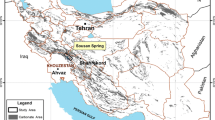Abstract
The recession hydrographs of karst springs provide important information about aquifer characteristics such as storage properties and drainage potential, karstification degree, and other hydrological features. The Faresban, Famaasb, Gonbad-e-Kabood, and Gian springs are the important karst springs which drain main karst aquifers in west of Iran. In this study, we evaluate hydrological characteristics of these four karst springs using different analytic equations. Almost, all the recession curves were well fitted by a function that consists of three main exponential terms. The initial portion of the recession curve represents the fast drainage of large fractures and conduits, ending with the slowly decreasing curve, where the drainage of rock matrix and small fissures or baseflow is dominant. The Gian spring has the largest storage volume but the lowest drained water (7%). Using Mangin’s equation, it is apparent that the baseflow supplies over 85% of the total drained water to the Gian spring, while a small quantity of total outflow is made up of quickflow periods. Of the water available to the Famaasb, Faresban, and Gonbad-e-Kabood springs, 85, 80, and 70% are drained during period of baseflow, respectively, whereas the quickflow periods have minor importance in some springs. Based on the Coutagne’s equation results, it can be concluded that the catchment of the Famaasb and Gonbad-e-Kabood springs have a karstified saturation zone with drainage channels that provide a rapid discharge with little storage capacity. At Gian catchment area, the initial discharge is not as rapid as karstification but is fairly homogeneous throughout the aquifer.












Similar content being viewed by others
References
Alavai M, Mahdavi MA (1994) Stratigraphy and structures of the Nahavand region in western Iran, and their implications for the Zagros tectonics. Geol Mag 131:43–47
Amit H, Lyakhovsky V, Katz A, Starinski A, Burg A (2002) Interpretation of spring recession curves. Groundwater 40:543–551
Atkinson TC (1977) Diffuse flow and conduit flow in limestone terrain in the Mendip Hills. Somerset (great Britain). J Hydrol 35:93–110
Bakalowicz M (1986) De l’hydrogeologie en karstologie. Jornadas Karst Euskadi. San Sebastian 2:105–129
Bonacci O (1993) Karst springs hydrographs as indicators of karst aquifers. Hydrological Sciences 38:51–62
Boussinesq J (1904) Recherches the’oriques sur l’e’coulement des nappes d’eau infiltre’es dans le sol et sur les de’bits des sources. Journal de Mathe’matiques Pures et Applique’es, Parise 10:5–78
Coutagne A (1968) Les variations de debit en peri ode non influence par les precipitations. La Houille Blanche Sept Oct pp 416–436
Fetter CW (1988) Applied hydrogeology, 2nd ed., Merrill Publ Co, Columbus, p 592
Ford D, Williams P (2007) Karst geomorphology and hydrology. Unwin Hyman, London, p 601
Freeze RA, Cherry JA (1979) Groundwater. Prentice Hall Inc, New Jersey, p 604
Galabov M (1972) Sur I’expression mathematique des hydrogrammes des sources et Ie pronostic du debit Bull BRG M Paris 2:51–57
Hall FR (1968) Base flow recessions: a review. Water Resour Res 4:973–983
Kresic N (2007) Hydrogeology and groundwater modeling, 2nd ed. CRC Press, Boca Raton, FL, p 805
Maillet E (1905) Essais dı’hydraulique souterraine et fluviale, Herman et Cie, Paris Vol 1
Mangin A (1975) Contribution it I’etude hydrodynamique des aquiferes karstiques. Lab Sout du CNRS (Moulis). These Doct Univ Dijon In Ann Speleol 30:21–124
Mangin A (1984) Pour une meilleure connaissance des systemes hydrologiques it partir des analyses correIatoire et spectraie. J Hydrol 67:25–43
Padilla AA, Pulido B, Mangin A (1994) Relative importance of baseflow and quickflow from hydro graphs of karst springs. Ground Water 32:267–277
Raeisi E (2008) Ground-water storage calculation in karst aquifer with alluvium of no-flow boundaries. Journal of cave and Karst studies 70:62–70
Raeisi E, Karami GH (1996) The govering factors of the physical and hydrochemical characteristics of karst spring. Carbonates and Evaporates 11:162–168
Samani N, Ebrahimi B (1996) Analysis of spring hydrographs for hydrogeological evaluation of a karst aquifer system. Theoretical & Applied Karstology 9:97–112
Singh KP (1969) Theoretical base-flow curves. J. Hydraul Div ASCE 95:2029–2048
Singhal BBS, Gupta RP (2010) Applied hydrogeology of fractured rocks, 2nd ed. Academic Publishers (now Springer), p 429
Soulios G (1991) Contribution a` l’e’tude des courbes de re’cession des sources karstiques: Exemples du pays Helle’nique. J Hydrol 127:29–42
Stocklin J (1968) Structural history and tectonics of Iran: review. AAPG Bull 52:1229–1258
Wells AJ (1969) The crush zone of the Iranian Zagros Mountains and its implications. Geol Mag 106:385–394
Williams PW (1983) The role of subcutaneous zone in karst hydrology. J Hydro 61:45–67
White WB (1988) Geomorphology and hydrology of carbonate terrain. Oxford University Press, p 464
Acknowledgement
We extend our appreciation to the Shahrood University of Technology for their financial support to this study.
Author information
Authors and Affiliations
Corresponding author
Rights and permissions
About this article
Cite this article
Bagheri, R., Jafari, H., Momeni, A. et al. Analysis of karst spring recession curves, west of Iran. Arab J Geosci 9, 731 (2016). https://doi.org/10.1007/s12517-016-2754-6
Received:
Accepted:
Published:
DOI: https://doi.org/10.1007/s12517-016-2754-6




